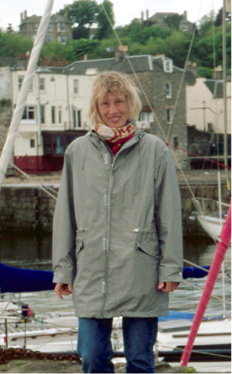
Dehalogenation
of dioxins and chlorophenols
The lab of Ute Lechner
 |
contact
projectsmembers of the grouppublications |
| 1. Reductive dehalogenation of chlorinated biaryls and
other chloroaromatics by enrichment cultures from anoxic river sediments of
Sachsen-Anhalt
Introduction
Aims
Introduction Aims
Desulfitobacterium:
3. Biodegradation of methyl tert-butyl ether (MTBE) by aerobic
bacteria Introduction MTBE has been used as oxygenating compound in gasoline since ca 25 years.
MTBE possesses a low taste and odor threshold and is a possible human carcinogen.
Due to its extensive use, freshwater resources have been impacted by MTBE
through accidental spills and leaking of storage tanks. In close cooperation
with the Environmental Research Centre (UFZ) Leipzig-Halle, we investigate
MTBE-degrading aerobic bacteria isolated from a MTBE-contaminated groundwater in
Leuna. Aims - Taxonomic description of the isolates, which constitute a new genus and new
species within the Betaproteobacteria - Determination of the frequency of these bacteria in contaminated
groundwater at the Leuna site and the response of cell number to different
remediation strategies using fluorescence in situ hybridization (FISH)
and other molecular methods - Elucidation of the degradation pathway: role of a carbon-skeleton
rearranging enzyme transforming the tertiary alkyl moiety into a straight carbon
chain, which is finally channelled to the tricarboxylic acid cycle
Bunge, M., Kähkönen, M. A., Rämisch, W., Opel, M., Vogler, S., Walkow, F., Salkinoja-Salonen, M. and Lechner, U. (2006) Biological activity in a heavily organohalogen-contaminated river sediment. ESPR – Environ. Sci. Pollut. Res., OnlineFirst (DOI: http://dx.doi.org/10.1065/espr2006.03.298). Rohwerder, T., Breuer, U., Benndorf, D., Lechner, U. and Müller, R. H. (2006) The alkyl tert-butyl ether intermediate 2-hydroxyisobutyrate is degraded via a novel cobalamin-dependent mutase pathway. Appl. Environ. Microbiol. 72, in press Ballerstedt, H., Hantke, J., Bunge, M., Werner, B., Gerritse, J., Andreesen, J. R., and Lechner, U. (2004) Properties of a trichlorodibenzo-p-dioxin-dechlorinating mixed culture with a Dehalococcoides as a putative dehalogenating species. FEMS Microbiol. Ecol. 47, 223-234. Bunge, M., Adrian, L., Kraus, A., Opel, M., Lorenz, W. G., Andreesen, J. R., Görisch, H., Lechner, U. (2003) Reductive dehalogenation of chlorinated dioxins by an anaerobic bacterium, Nature 421, 357-360 Breitenstein, A., Wiegel, J., Haertig, C., Weiss, N., Andreesen, J. R., Lechner, U. (2002) Reclassification of Clostridium hydroxybenzoicum as Sedimentibacter hydroxybenzoicus gen. nov., comb. nov. and description of Sedimentibacter saalensis sp. nov. Int. J. Syst. Evol. Microbiol. 52, 801-807. Breitenstein, A., Saano, A., Salkinoja-Salonen, M., Andreesen, J. R., Lechner, U. (2001) Analysis of a 2,4,6-trichlorophenol-dehalogenating mixed culture and isolation of the dehalogenating member Desulfitobacterium frappieri strain TCP-A. Arch. Microbiol. 175, 133-142. Bunge, M., Ballerstedt, H., Lechner, U. (2001) Regiospecific dechlorination of spiked tetra- and trichlorodibenzo-p-dioxins by anaerobic bacteria from PCDD/F-contaminated Spittelwasser sediments. Chemosphere, 43, 675-681. Bunge, M, Lechner, U. (2001) Anaerobic transformation of dioxins by bacteria from contaminated sediments: diversity of the dehalogenating community. In: Schriftenreihe des Sonderforschungsbereiches 193 der Technischen Univeristät Berlin „Biologische Behandlung industrieller und gewerblicher Abwässer", Bd. 15: Anaerobic dehalogenation, S. 69-81. Bunge, M., Werner, B., Lechner, U. (2000) Properties of a dioxin-dechlorinating microbial consortium from an acidic sulfate-rich river sediment. Organohalogen Compounds, 45, 456-459. Bunge, M., Ballerstedt, H., Lechner, U. (1999) Different regioselectivities of reductive dioxin-dechlorination by anaerobic bacteria from river sediments of the Bitterfeld district. Organohalogen Compounds 41, 387-390. Fritsche, K., Lechner, U. (1999). Defluvibacter lusatiae gen. nov., sp. nov., a new chlorophenol-degrading member of the -2 subgroup of the Proteobacteria. System. Appl. Microbiol. 22, 197-204. Ballerstedt, H., Werner, B., Gerritse, J., Lechner, U. 1998. Anaerobic bacteria from sediments dechlorinate dioxin congeners. In: Microbiology of polluted aquatic ecosystems, pp. 58-64 (Becker, P. M., ed.). Proceedings of the workshop held at UFZ, Leipzig 4.-5. Dec. 1997. Fritsche, K., Lechner, U. 1998. Molecular biology of chlorophenol degradation catalyzed by a bacterium of the Rhizobiaceae group. In: Microbiology of polluted aquatic ecosystems, pp. 102-108 (Becker, P. M., ed.). Proceedings of the workshop held at UFZ, Leipzig 4.-5. Dec. 1997. Ballerstedt, H., Kraus, A., Lechner, U. 1997. Reductive dechlorination of 1,2,3,4-tetrachlorodibenzo-p-dioxin and its products by anaerobic mixed cultures from Saale river sediment. Environ. Sci. Technol. 31, 1749-1753. Makdessi, K., Lechner, U. 1997. Purification and characerization of 2,4-dichlorophenol hydroxylase isolated from a bacterium of the alpha-2 subgroup of the Proteobacteria. FEMS Microbiol. Lett. 157, 95-101. Lechner, U., Baumbach, R., Becker, D., Kitunen, V., Auling, G., Salkinoja-Salonen, M. 1995. Degradation of 4-chloro-2-methylphenol by an activated sludge isolate and its taxonomic description. Biodegradation 6, 83-92.
|
|||||||||||||||||||||||